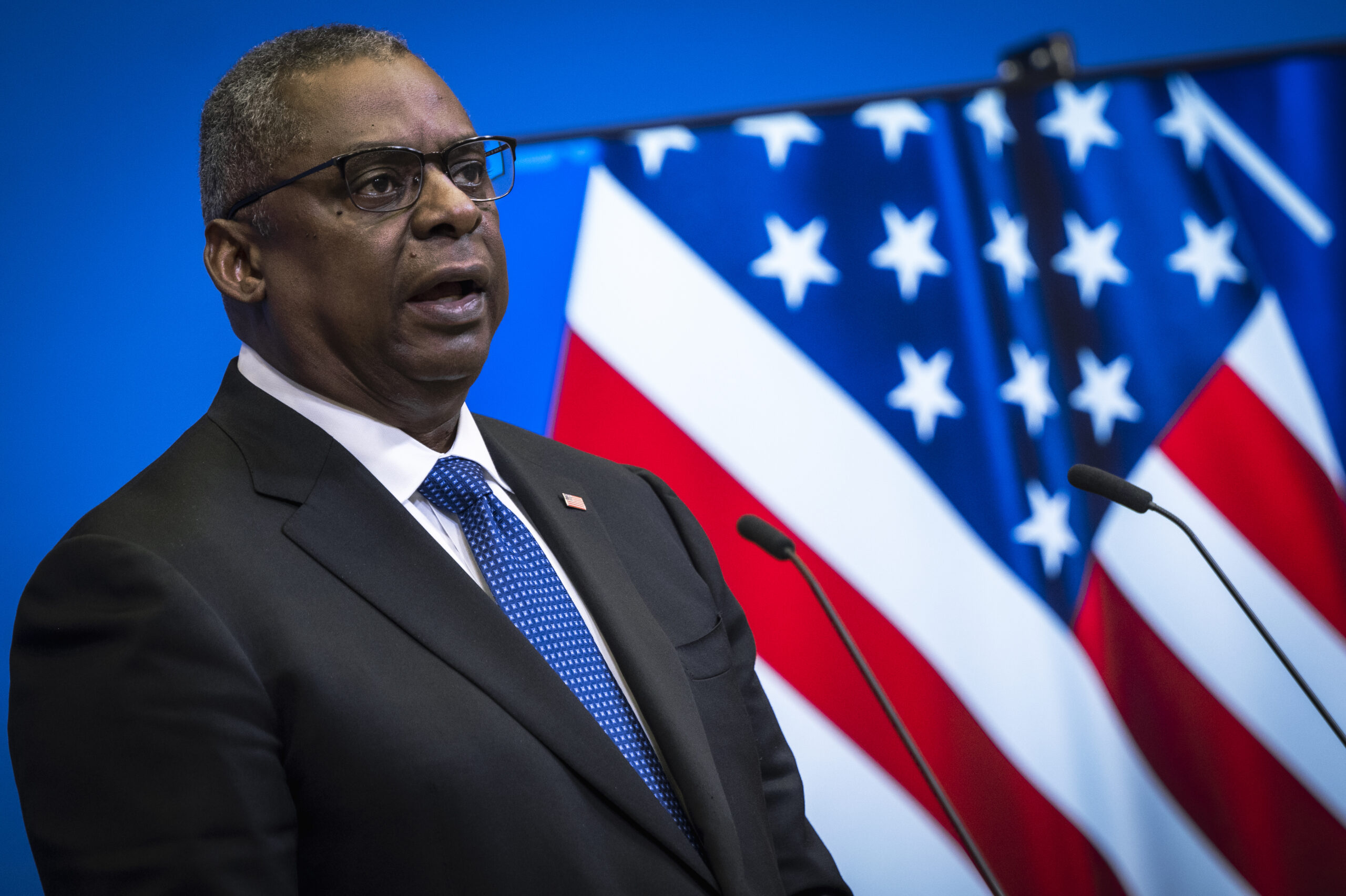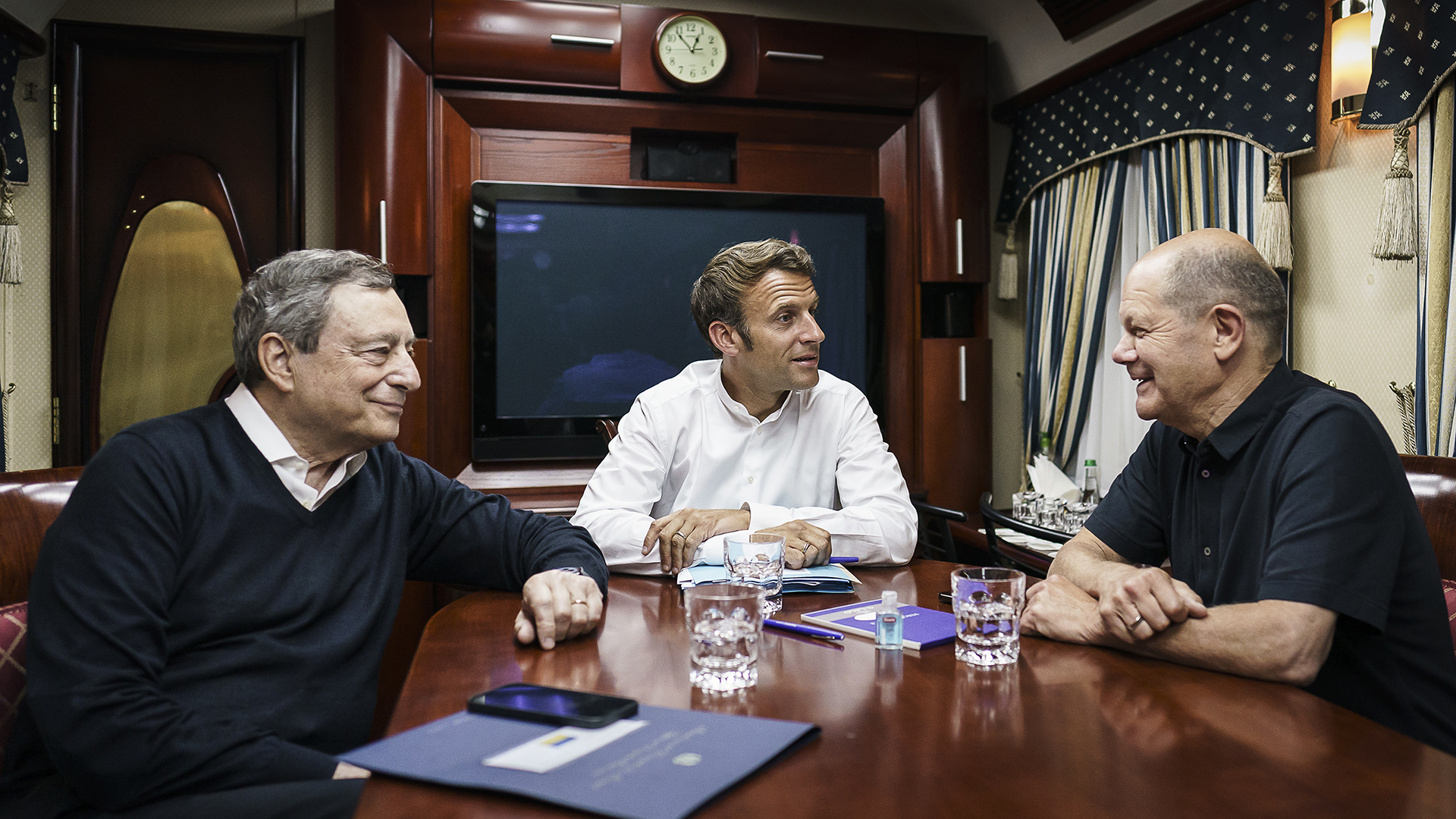The leaders of France, Germany, Italy and Romania traveled to Kyiv to meet with Ukrainian President Volodymyr Zelensky and get a first-hand account of what military aid the country needs to fight off the Russian invasion. The meeting occurred at the same time that defense ministers and other officials from 50 nations gathered at NATO headquarters in Brussels, Belgium to chart a course forward on international military, economic and humanitarian aid to Ukraine.
French President Emmanuel Macron, German Chancellor Olaf Scholz and Italian Prime Minister Mario Draghi trained in from Poland to the Ukrainian capital, where they were met by Romanian President Klaus Iohannis.
Macron, Scholz and Draghi rode from Poland in a private train car from Poland to Kyiv.
The train is the same or similar to the one Polish Prime Minister Mateusz Morawiecki, along with Slovenian Prime Minister Janez Janša and Czech Prime Minister Petr Fiala, rode into Ukraine on last March.
Oleksandr Kamyshin, chairman of Ukrainian Railways told CNN at the time that traveling by rail was the safest option for foreign heads of state, despite Russian strikes on civilian railway stations. Kamyshin said the delegation in March rode a special train consisting of four new sleeper cars.
“It was a regular, normal train, with normal rail cars,” Kamyshin told CNN. “So [the delegation’s route] was not more special than the others. … It was the same track that normal passengers take as well.”
Thursday’s delegation traveled with Zelenskyy to Irpin, outside Kyiv, where Iohannis said there were “no words to describe the unimaginable human tragedy and horrible destruction we saw.”
“I strongly renew my appeal for all Russian perpetrators to be held responsible by the international criminal justice, which Romania fully supports,” Iohannis tweeted.
Tweeting in both French and Ukrainian, Macron said of Irpin, “We saw a devastated city and traces of barbarism. And also the heroism of Ukrainian men and women who stopped the Russian army when it went to Kyiv. Ukraine is resisting. She must be able to win.”
Macron on June 16 announced France would add another six CAESAR self-propelled 155mm howitzers to the 12 it has already sent Ukraine. He also tweeted a video of one of the cannons loading onto an Antonov Airlines AN-124-100 transport aircraft for shipment to the frontlines.
“Until peace returns to a free and independent Ukraine, we will continue to mobilize our efforts for as long as necessary,” Macron said. “Humanitarian, economic and military support to enable Ukrainian soldiers to improve the situation on the ground in the face of attacks by the Russian army.”
Another pledge of support for Ukraine rolled in from the U.K. British Secretary of State for Defense Ben Wallace announced his country has purchased at least 20 M109 self-propelled howitzers “on the global market” for Ukraine. The BBC reports that the artillery systems were refurbished by a Belgian arms manufacturer.
Plenty has happened in the 48 hours since we have updated readers on the war in Ukraine. Before we wade into the details, take a moment to catch up on our previous rolling coverage of the conflict here.
The Latest
Fresh off the announcement of an additional $1 billion in U.S. security assistance to Ukraine, Secretary of Defense Lloyd Austin offered an update on June 16 on the second day of a NATO ministerial. The meeting is setting the groundwork for a full-on NATO summit scheduled for later this month in Madrid, Spain.
Formed as an international bulwark against the Soviet Union, NATO is again fully focused on defeating Russia.

“This alliance has met the challenge with determination, with resolve and, above all, with unity,” Austin said in a press conference from Brussels. “Together, we have responded swiftly and decisively to Russia’s baseless and lawless and reckless invasion of Ukraine. NATO has shown the world that it remains the essential forum for consultation, decision and action on transatlantic security. We’re all proud to stand with the brave people of Ukraine as they defend themselves, their democracy and their sovereignty.”
NATO allies have activated preset collective defense plans, deployed elements of the NATO Response Force, and placed tens of thousands of troops in the eastern areas of the alliance, along with significant air and naval assets under the direct command of NATO and supported by allies’ national deployments, Austin said.
“NATO is also making plans to strengthen its deterrence and defense posture for the longer term, especially along the eastern flank,” he said. “Now, NATO is also close to welcoming two new members to the alliance. Finland and Sweden have made the historic decisions to apply for membership and that reflects the appeal of NATO’s core values.”
Regardless of which side destroyed them, all of the bridges over the Donets river linking the besieged city of Severodonetsk with Ukrainian-held territory to the west are in all likelihood destroyed, according to the U.K. Ministry of Defense’s latest intelligence assessment of the war. Most Ukrainian forces were likely able to withdraw across the river before those paths of retreat were severed.
Russia’s combat forces in the east are now likely organized into understrength ad hoc groupings, the U.K. MoD said. Some Russian battalions that initially fielded from 600 to 800 troops can now muster 30 or so soldiers. Those units are finding it difficult to make territorial gains in urban fighting where Russia’s numerical superiority in tanks and artillery are less advantageous, according to the U.K. MoD.
Footage of some of the savage house-to-house urban fighting in Severodonetsk was posted to social media by Georgian volunteers on June 15.
Speaking of bridges, a senior Ukrainian general is threatening to use Western-supplied weapons to destroy a bridge between Crimea and mainland Ukraine that has served as a key supply route for Russian forces attacking from the south, The Telegraph reports.
For helicopter crews — both Russian and Ukrainian — flying low and fast is the name of the game in order to avoid enemy man-portable air defense systems (MANPADS) as well as other defenses. So eager was one Russian Ka-52 attack helicopter pilot to hug the earth that the aircraft’s rocket pod and stub wing clipped a tree. The impact, which tore off a piece of the tree, also appears to have damaged a directional infrared countermeasures (DIRCM) system mounted below the root of the Ka-52’s stub wing.
Russian Ka-52s are still flying around wildly lobbing unguided rockets at Ukrainian positions.
Video also has emerged of a Ka-52 successfully killing a Ukrainian tank and another armored vehicle with anti-tank guided missiles in the east.
Those attacks did not go unanswered. A drone on June 16 captured Ukrainian forces downing a Russian Mi-35 Hind attack helicopter with some sort of MANPADS in the Donetsk region. The remarkably clear video shows the aircraft flying low over green fields separated by hedgerows when it suddenly bursts into flames, crashes and burrows into the ground. It’s a reminder of just how fast things can go from fine to horrible for helicopter crews flying over the battlefield.
Flying low is not just for helicopters, as the driver of this car in Belgorod found out first-hand when a pair of Russian Su-25 jets roared overhead.
Also shot down yesterday was an apparently rare Russian Merlin-VR, a medium-altitude, long-endurance unmanned aerial system used for reconnaissance and targeting.
Both sides are deploying anti-drone technologies to contend with commercial and military unmanned aerial systems (UAS) of all shapes and sizes, flocking overhead to spy and drop bombs on their positions. Now those counter-UAS systems, which can emit electronic signatures that enemy forces can presumably target, are becoming targets of opportunity for opposing long-range fire weapons. Ukraine’s National Guard recently homed artillery fire on a Russian counter-UAS system atop a large building helpfully marked with a Russian flag flapping out front.
More footage of a Ukrainian MiG-29 decked out in flashy “Patriotic” livery patrolling the skies emerged online. The jet was operated by the Ukrainian Air Force’s “Ukrainian Falcons” aerobatic team and was seen flying with R-73 short-range and R-27 medium-range air-to-air missiles.
A Ukrainian Army unit was able to recover a Russian TOS-1A thermobaric multiple launch rocket system in working order. It and two T-72B tanks taken from the Russians will be put into service against their former owners.
As much attention as the AeroVironment Switchblade 300 suicide drone has gotten for its use in this war, they apparently are not so highly regarded by Ukrainian troops. The relatively expensive flying bombs are lightly armed and more difficult to operate than commercial-grade quadcopters. CNN reports that some Ukrainian soldiers prefer commercial drones over Western-supplied UAS designs equipped with explosives.
Another AeroVironment drone, promised to Ukraine by the company in April, showed up in service there just this week. The Quantix Recon tail-sitter drone can take off and land vertically then transition to forward flight and is light enough for one person to carry and operate.
So poorly have Russia’s Project 22160 patrol ships performed in the war that a defense industry source told the state-run TASS news outlet that Russia will not purchase six more ships, as it had planned. Issues with the ships include concerns over their seaworthiness, armor, engines, and air defenses. At least one of the ships was outfitted with a Tor air defense system to boost its defenses against Ukrainian attacks.
A Russian missile struck celebrity chef Jose Andres’ World Central Kitchen train. No one was hurt in the strike and though a car full of food the organization prepares and distributes to Ukrainian civilians was destroyed, Andres vowed to “keep feeding the people.”
Ukraine’s Defense Ministry got literary on Twitter, describing Defense Minister Oleksi Reznikov’s meeting with NATO counterparts as the Council of Elrond from The Lord of the Rings. NATO stands in for the nations of J.R.R. Tolkein’s fictional Middle Earth, aligned against the “Evil from Mordor” that is Russia.
A group of unidentified Ukrainian fighters posted an interesting bit of video to social media showing them appearing to emerge dramatically from a lake with various weapons in superhero style. “What іs your superpower?” they ask. “We are Ukrainians!”
As ever, humanity finds a way to claw through the horrors of war. On Thursday, such a ray of light was provided by Ukrainian soldiers launching an operation dedicated to rescuing a wounded dog from Russian shelling.
Elsewhere, Ukrainian troops took time to comfort a couple of deer fawns, trembling in fear of a Russian missile bombardment.
We will continue to update this story until we state otherwise.
Contact the author: Dan@thewarzone.com
